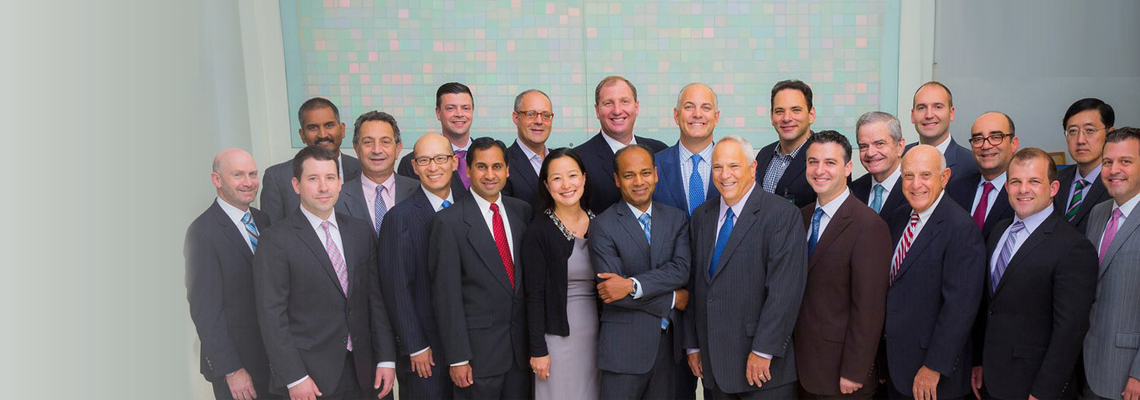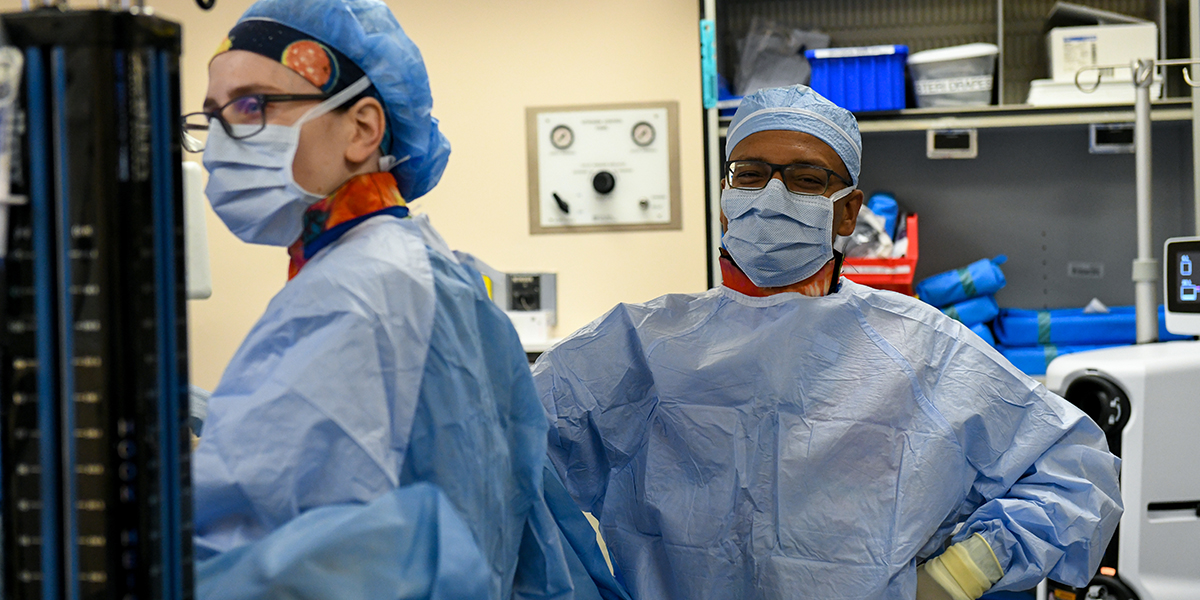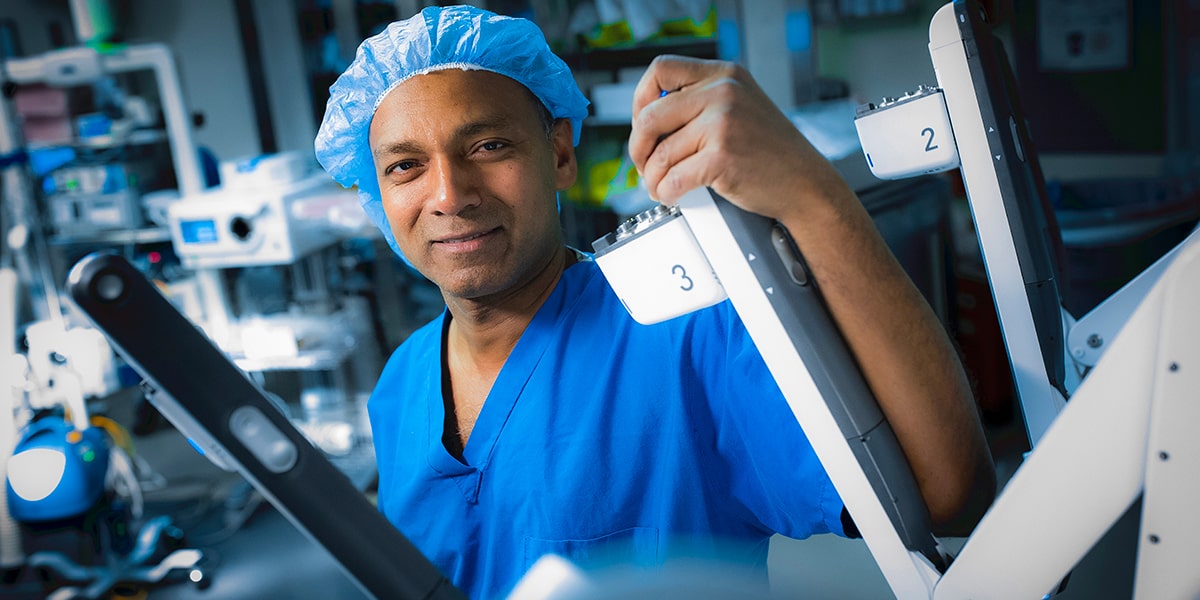
Robotic Surgery for Urology Conditions
You have access to New Jersey’s largest and most successful robotic urology surgery program at Hackensack Meridian Health. Our experienced surgeons offer outcomes for robotic surgery of the prostate, kidney, bladder and urinary tract, including cancer. that place us among the best centers in the nation.
Hackensack Meridian Health has long been recognized as a pioneer in robotic surgery. Twenty years ago, our surgeons were among the first in the United States to perform robotic surgery. Today, that innovation continues with our single-port approach. This means you have surgery with only one incision, an easier recovery and a faster return to doing the things you love.
Watch the video below to learn more about robotic surgery for urologic conditions.
"Single-port technology is further enhancing our ability to minimize trauma to the patient and allowing us to do surgeries we couldn't do with multi-port." - Michael D. Stifelman, MD, Chair of Urology and Robotics
Benefits of Single-Port Robotic Urology Surgery
We were among the first in New Jersey and among the first in the world to offer a single-port approach. Today, most of our minimally invasive urology surgeries are performed this way for patients who meet the criteria. The advantages of single-port robotic surgery include:
- One incision, and less tissue damage
- Increased precision – with greater flexibility, stability and range of motion than a human hand
- Decreased blood loss and reduced need for transfusions
- Less risk of infection
- Less pain after surgery
- Smaller external and internal scars
- Shorter hospital stay
- Faster recovery and return to normal activities
Expert Robotic Urology Surgeons In New Jersey
Find a robotic bariatric surgeon or surgery center near you.
Robotic Surgery for Your Urology Conditions
Adrenal Cancer and Adrenal Tumors
- Adrenalectomy: Removal of one or more adrenal glands
- Partial Adrenalectomy: Removal of adrenal tumor that preserves unaffected adrenal tissue
- Cystectomy Ileal Conduit: Removal of the bladder and create a new way to pass urine
- Cystectomy Indiana Pouch: Type of urinary diversion after bladder removal
- Cystectomy Orthotopic Neobladder: Bladder reconstruction that uses a piece of intestine to create a new bladder
- Partial Cystectomy: Removal of part of the bladder
Bladder Diverticula
- Diverticulectomy: Removal of the diverticulum of the bladder to relieve an obstruction
- Simple Prostatectomy: Procedure to treat extreme enlargement of the prostate
- Fistula Repair: Surgery to repair fistula, which is an abnormal connection between two body parts inside the body
- Nephrectomy: Removal of one or both kidneys
- Nephroureterectomy: Removal of the kidney, ureter, and a portion of the bladder where it connects to the ureter
- Partial Nephrectomy: Removal of a portion of kidney
- Prostatectomy: Partial or complete removal of the prostate
- Cyst Marsupialization: Cyst removal using a technique that prevents regrowth
Retroperitoneal Fibrosis
- Retroperitoneal Lymph Node Dissection: Removal of abdominal lymph nodes to treat testicular cancer.
UPJ Obstruction and other Ureteral Strictures
- Buccal Mucosa Urethroplasty: Use of a buccal mucosa graft in urethral reconstruction
- Pyeloplasty: Reconstructive surgery to repair narrowing or scarring where the ureter attaches to the kidney
- Ureterolysis: Procedure to relieve ureteral obstruction
- Ureteral Reimplant: Repair of the tubes that connect the bladder to the kidneys
- Ureterocalicostomy: Reimplantation of the ureter into the bladder
- Segmental Ureterectomy: Remove the cancer and preserve the ureter and kidney
- Nephro-Ureterectomy: Remove the kidney and ureter, along with nearby lymph tissue and fat if necessary
Ureteral Reflux
Robotic Urology Surgery Expertise

Experience
- One in every four robotic surgeries in New Jersey is performed at Hackensack Meridian Health.
- More than 775 robotic procedures a year, and more than 5,000 in the past decade, have been performed at Hackensack University Medical Center – the most of any center in New Jersey.
- About 90 percent of the major urology surgeries at Hackensack University Medical Center use robotic technology.
- More than 80% of our surgeons perform robotic urology surgery.
Single-Port Robotic Surgery Leaders
- National Leader: One in five single-port robotic surgeries in the United States is performed at Hackensack Meridian Health.
- First in New Jersey: Hackensack University Medical Center was among the first hospitals in the world — and the first in New Jersey — to use a single-port robotic system for urology surgeries.
- Pioneers: Our surgeons helped develop single-port surgery for all urology cancers and a broad range of urology conditions.
- Others Learn from Us: Surgeons from around the world travel to Hackensack to train with us. Our studies on robotic urology surgery have been published in academic journals and presented at international conferences.
Robotic Urology Medical Education Programs
Frequently Asked Questions
The primary benefits for patients when choosing robotic surgery over traditional open surgery include:
- Smaller incisions
- Less pain
- Lower risk of infection
- Less blood loss and fewer transfusions
- Shorter hospital stays
- Less scarring
- A faster recovery and return to normal activities
Hackensack Meridian Health uses robotic surgery to treat a wide range of urologic conditions, including:
- Adrenal Gland Tumors
- Bladder Cancer (cystectomy)
- Kidney Cancer (partial and radical nephrectomy)
- Kidney Obstruction (pyeloplasty)
- Prostate Cancer (prostatectomy)
- Testicular Cancer
- Ureteral Cancer

















